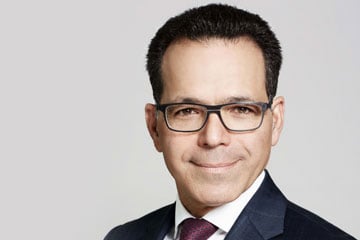
Veteran Montreal litigation lawyer Gerry Apostolatos says women accounted for “maybe six per cent” of lawyers in Quebec when he started practising nearly 30 years ago.

Veteran Montreal litigation lawyer Gerry Apostolatos says women accounted for “maybe six per cent” of judges in Quebec when he started practising nearly 30 years ago.
But he credits social change, the determination of women lawyers and a variety of actions by the Barreau du Québec with helping to close the gender gap on the bench and within the legal profession, especially among young lawyers and the student bodies at all five of the province’s law schools, where women now make up the majority.
“These kinds of ethical issues go beyond law,” says Apostolatos, a partner and board chairman at Langlois Lawyers, which in January announced five new partners for 2018 — all of them women. “They are about life and making things better.”
He sees the Panorama Project in much the same light.
Spawned from the 2014 report from the Barreau du Québec on the Forum Project, the largest consultation exercise ever conducted by the provincial regulator among lawyers and students from racialized groups, the Panorama Project is a three-year action plan aimed at helping to increase the ethnocultural diversity of the legal profession in Quebec.
Inaugurated in June 2016, the project involves 28 voluntary participants, including 23 national and regional law firms (including BCF, Borden Ladner Gervais LLP, Fasken Martineau DuMoulin LLP, Langlois, McCarthy Tétrault LLP, Norton Rose Fulbright LLP, Stikeman Elliott LLP and Lavery de Billy) and the legal departments at five major Quebec companies (including SNC-Lavalin and the Caisse de dépôt et placement du Québec). In all, the participants employ 2,300 Quebec lawyers.
Participants pledged to do five things. They include carrying out surveys to identify and quantify their lawyers from ethnocultural groups and the development and putting in place of best practices for the recruitment, retention and advancement of lawyers from those groups.
They also agreed to measure the progress of their hiring practices, implement measures to promote the values of ethnocultural diversity and inclusiveness and file annual reports on those initiatives.
The results of the surveys and those actions will be made public this summer.
One lawyer involved with the Panorama Project says the results will likely be “in line” with a finding in the Barreau’s Forum Project that while 13 per cent of Quebec’s population of nearly eight million people self-identify in one of 10 racialized groups, lawyers from those groups account for only six per cent of the province’s nearly 27,000 lawyers (though students from those groups now represent nearly 20 per cent of law students in Quebec).
Another finding in the Forum Project was that lawyers from racialized groups face unique challenges getting into the profession, starting practice and advancing in the field.
Other actions under Project Panorama are aimed at identifying and breaking down cultural barriers. They include the development of a two-hour, for-credit training course on unconscious bias, a panel on diversity put on this winter by the law faculty and students at the Université de Montréal and the upcoming publication of a best-practices hiring guide.
Many of those initiatives have been either fleshed out, filled in and/or approved at the biannual meetings between the managing partners of participant firms and the batônnier of the Barreau du Québec, Paul-Matthieu Grondin, the five group meetings that have been held with at least one representative from each firm present and at the many working group sessions that have been held over the past two years.
“Panorama will provide us with the data we want and need in order to begin addressing the issue of diversity as a profession,” says Grondin.
Similar efforts and solutions are being developed by bar associations in Canada, the United States and the United Kingdom.
Unlike in Ontario, where the law society’s recent adoption of a statement of principles on diversity has angered many lawyers, voluntary Barreau-backed efforts such as the Panorama Project are being positively embraced by the Quebec legal community, says Grondin.
“There is broad agreement on the need for a correction in regards to the representation of ethnocultural groups to make our profession more inclusive,” says Grondin. He says he is confident that initiatives like Project Panorama will help to address the situation, much like mentorships, reserved law school seats and other actions have helped to increase the number of Indigenous lawyers in Quebec.
“I think awareness, training and education are fundamental,” adds Apostolatos, a native Montrealer and Greek-Canadian who represents Langlois at both levels of Panorama Project participants’ meetings — the only lawyer to do so. “Seeing and understanding and embracing diversity in the workplace is an evolution that, at the end of the day, makes us all richer and happier and better off.”
Editor's Note: this story has been updated to clarify that Gerry Apostolatos says women accounted for “maybe six per cent” of judges in Quebec, not six per cent of lawyers in Quebec.